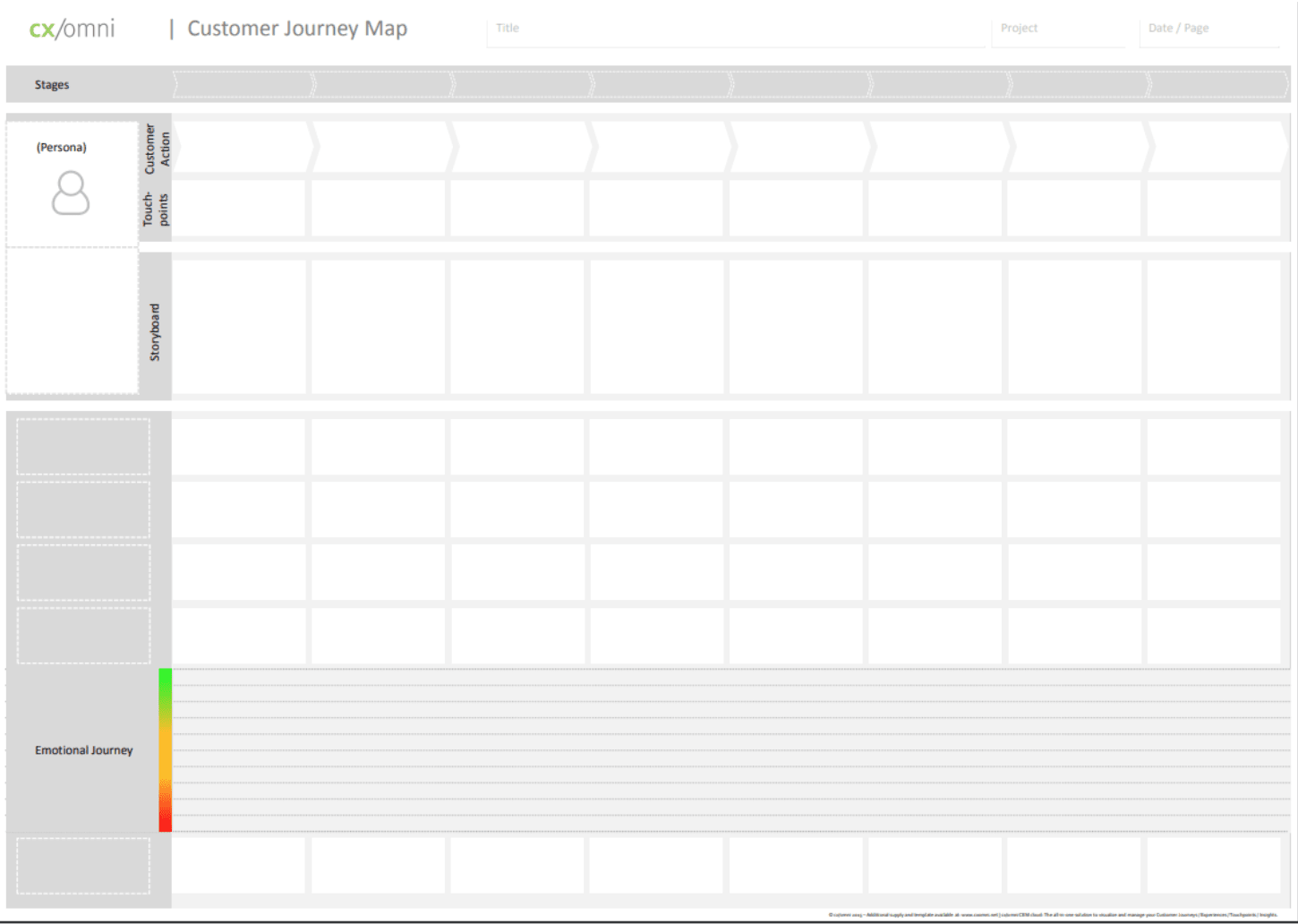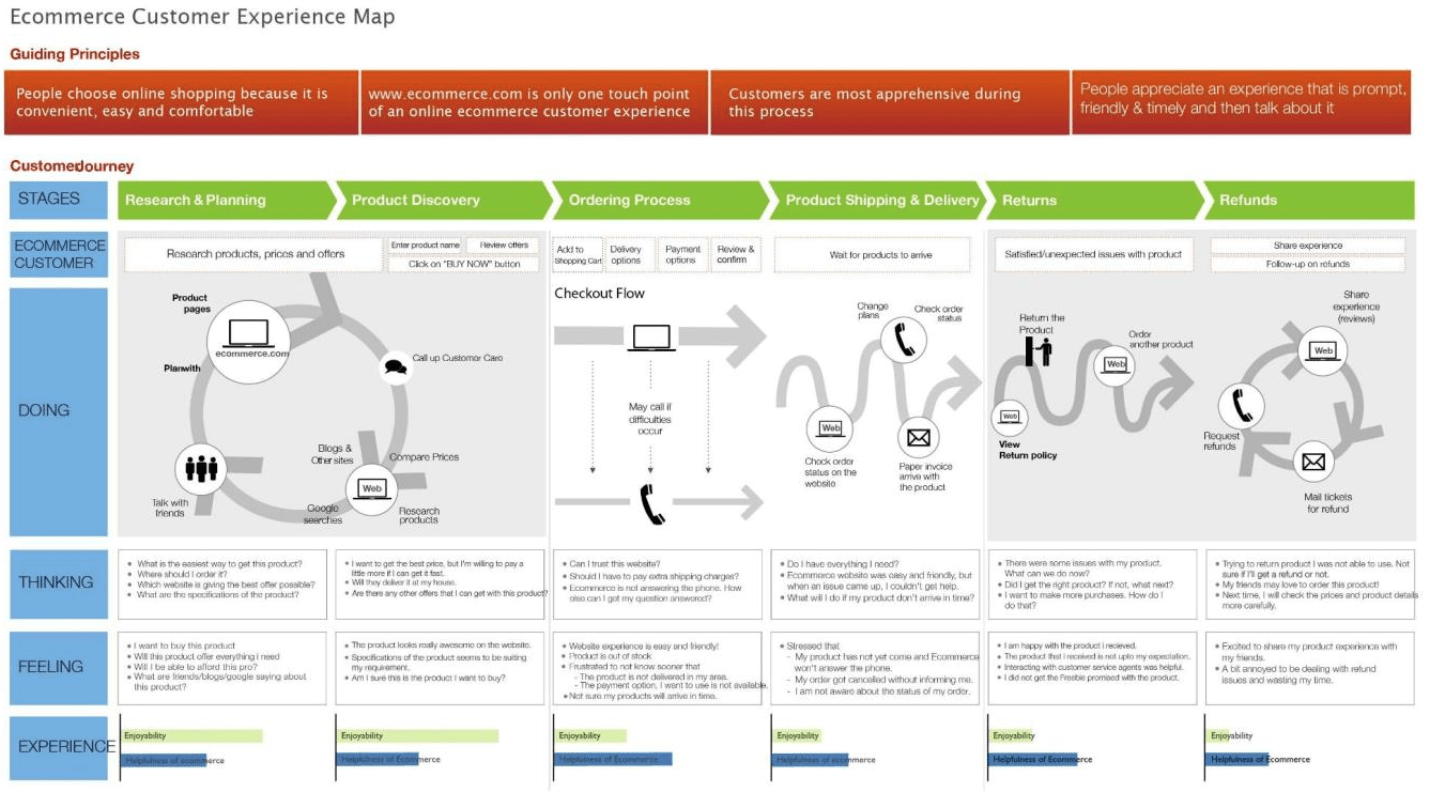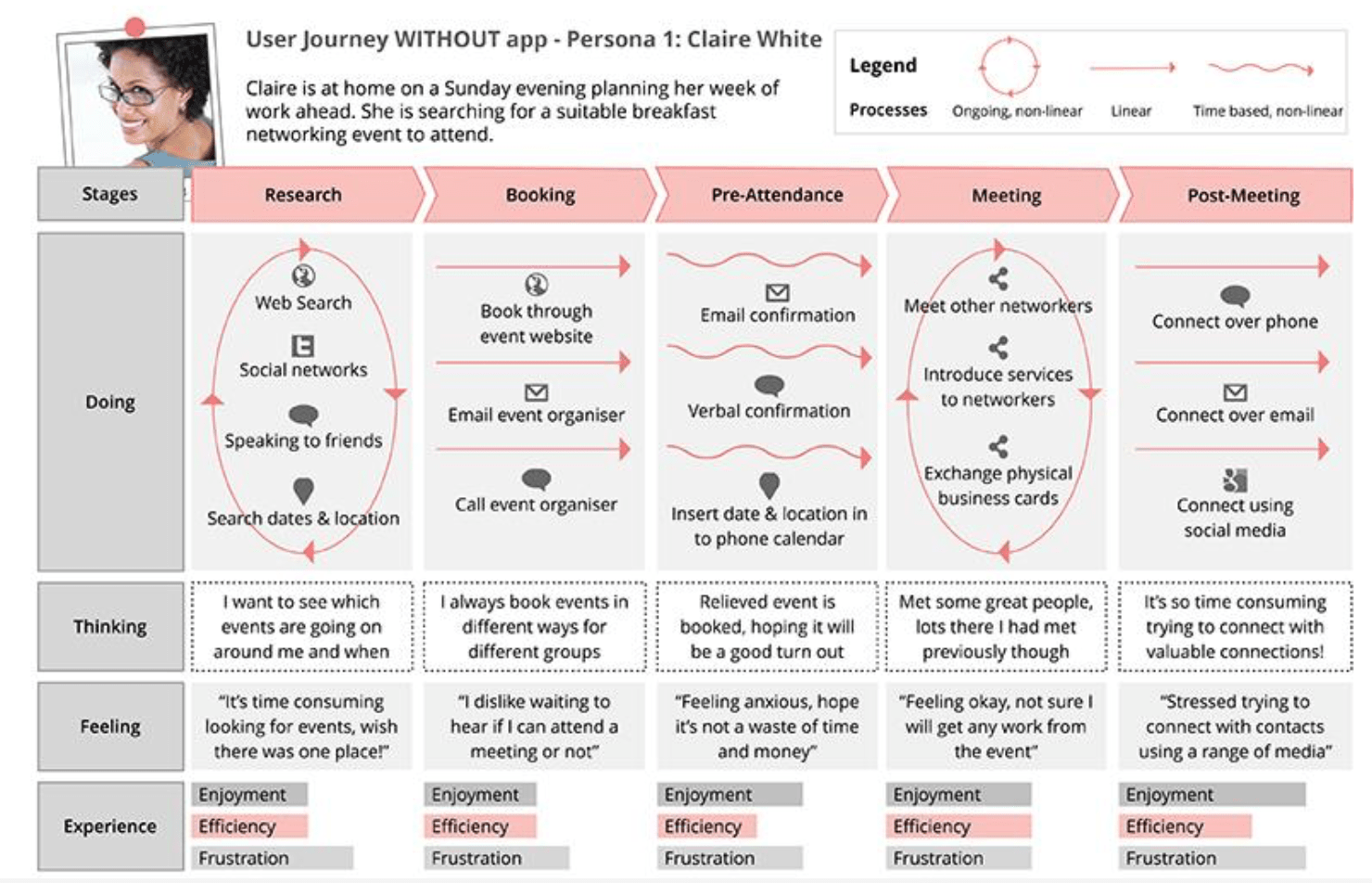Different techniques to define the end-user of a software product.
We will discuss the following topics and how to best use them:
- Personas and User Journeys
- Guide to Customer Journey Mapping
- Buyer personas
- Channels, Stages And Departments
- Micro Moments
- Touchpoints
- Emotional Journey
- Preparation
- Execution
- Sharing and Communicating
- Illustrating The Big Picture
PERSONAS AND USER JOURNEYS
Outline a persona
A persona is a synthesis of available evidence about the archetypal kind of individual(s) who takes the journey you are about to map. To get ahead of the field, try to describe an early adopter, ‘digital native’ or extreme personas.
Personas instead of target groups
In content marketing and customer experience management, a “buyer persona“ refers to a precisely defined, typical target group representative. While target group definitions are rather vague and are represented as a faceless and anonymous dataset (such as Sinus milieus), the application of the buyer persona methodology brings the customer to life.
The buyer persona is a prototype for a group of users with distinctive features and a specific usage behavior. Personas are used in requirement management of software as well as in customer experience management. For a software in planning, it will be analyzed which group of users will use this application later. For this purpose, a few fictional characters are created based on observations of real people that are representatives of the majority of the subsequent actual users.
The application is then created by the design and development team which picks up the needs of these fictional characters and plays through different operation scenarios accordingly.
Start with your buyer personas
First, give your buyer personas a name and assign a typical image to them. In addition, define demographic data, values and goals. Document emotions and personal behaviors as well. Optionally, you may visualize them as a mood board with pictures of typical consumer worlds.
In order to segment your personas, bring your key stakeholders from sales, service, marketing and management CX together. This inter-disciplinary exchange aswell as workshop results, surveys, market research, etc. represent the basis of the design and the common understanding of your personas.
The personas defined as such create transparency for all parties involved and will simplify your corporate communication about needs, expectations and customer behavior. The knowledge about how the customer accesses information and which channel sand with what expectations are used during the customer journey, allows you to pursue a differentiated approach to customers groups.
Buyer personas in customer experience
In the cx system, you can customize your personas dashboard individually and configure specific consumer characteristics for your industry in addition to the standard characteristics and display them visually on a scale. The typical features of buyer personas can also be represented in the form of persona stories.
Map a User Journey
Identify journey elements. Based on the data you have gathered, and your understanding of your personas, identify the following elements.
- Phases
- Touchpoints
- Task goals
- Information accessed
- Decisions made
- Thoughts
- Feelings
- Emotion map
- Triggers and highlights
- Barriers and lowpoints
- Low points
- Opportunities
The journey should be i. grounded in actual data ii. represent either the present or the future. iii. put the online story in broader context, in particular relate online touchpoints to off-line systems and events, as well as other systems and services in the daily ecosystem
b) Sketch out, and then draw, a user journey diagram. A basic template is overleaf. You may also like to create an online user journey at www.uxpressia.com.
Template

Example (E-Commerce)

GUIDE TO CUSTOMER JOURNEY MAPPING
Always document from the outside-in perspective, meaning from the customer view
I've learned that people will forget what you said, people will forget what you did, but people will never forget how you made them feel.
— Maya Angelou
CUSTOMER EXPERIENCE MANAGEMENT
Customer Journey
The journey of a potential customer a long different touch points with a product, a brand or a company. All points of contact (direct and indirect touch points) of a consumer with a brand, a product or service.
Customer Experience
Measures the individual experience at all touch points in relation to customer expectations at these touch points. The cumulative experience of many touch point impressions through out the entire customer life cycle.
Customer Experience (CX) Management
Customer orientation, emotional differentiation and customer enthusiasm –these are objectives that require new actions in marketing, sales and IT. Customer Relationship Management (CRM) was just the beginning and is enhanced by continuously planning, controlling and managing the customer experience at all touch points. Such Touchpoint Management and Customer Experience Management are the success factors in Marketing.
CRM versus CEM
With a CRM system, you control chronological activities and campaigns with individual customers. In contrast, a CRM system records all interactions with individual clients, CEM (Customer Experience Management) follows the approach to enhance your CRM system by visualising personas, touchpoints, customer experiences and customer journeys.
The goal is to understand and rate the overall process in terms of pain points, but also exceptional customer experiences and emotional differentiation. Accordingly, there is no either-or, but a valuable combination: To manage the "Customer Relationship" and simultaneously plan, measure and continuously optimize the emotional experiences at the contact points for enterprises.
CEM-System
A CEM system like cx supports the following substantial optimization approaches in the context of customer management. Improve brand awareness/ brand value. Simplify Information. Increase perceived customer value. Improve user experience with interactions. Raise conversion rate. Increase "Share-of-wallet".
Create emotional customer experience. Communicate services proactively. Maintaining loyalty. Stimulate referrals. Customer management, customer experience management, touchpoint management and customer journey mapping have a pleasant destination: More sales and satisfied customers.
The inside-out perspective:
Well-organized, process-optimized, different silos.
Understanding customer journeys
Customers today expect a consistently positive experience when interacting with companies and brands. The customer journey mapping as a method to understand the customers‘ needs early and thus formulate specific internal improvement measures was developed by Oracle's Brian Curran and John Kembel in collaboration with Stanford University.
Other variants were developed by McKinsey and further consulting firms. With this method, the documentation of the customer perspective is carried out step by step on a time axis, where in the procedure may vary slightly depending on the model. These concepts primarily overlap in their approaches but there is no universal standard for the presentation. The motivation of the customer – and the emotions during a purchase or service process – a real ways the focus.
A picture and a quote turn an abstract target group into an emotionally understandable (buyer) persona.
CHANNELS, STAGES AND DEPARTMENTS
Outlining the path of the customer journey
Channel diversity and complexity
The complexity of marketing campaigns is increasing and so are the requirements for consistent brand management. Where as an advertising campaign typically used to be delivered using a few traditional media channels, now a days online channels such as email and social media are used aswell.
Simultaneously, the interaction speed in customer communications is increasing. Yet the alternation of channels is typical and in marketing also referred to as multi-channel strategy. Therefore, one crucial aspect is to link sales channels with each other so that the customer can move seamlessly from one channel to another during the customer journey.
At the same time, the customer comes into contact with various departments of the company in different stages of the shopping or service journey and expects consistent behavior and knowledge of his status.
Structuring stages of the customer journey
Start the journey by specifying all the channels, departments and stages involved. For departments, it is best to use your existing department names and department codes. For channels, choose designations as you use them in your marketing plan.
For stages and channels the following rule applies: as many as necessary, as few as possible. Fewer channels and stages make your customer journey maps more transparent. Create divisions of channels and stages only in the way you want to evaluate later. In the maps in cx, stages are represented as stage arrows and departments and channels can be visualized with unique colors.
Examples of stages:
- Inspiration
- Investigation/Perception
- Consideration
- Offer
- Purchase
- Delivery
- Use
Typical channels:
- Online / Mobile
- E-mail/ Newsletter
- Radio / TV
- Phone
- POS
- PR
- Social Web / Blogs
- Packaging / Product
- Form
MICRO MOMENTS
What do our customers expect?
I want to know I want to go I want to buy I want to do I want to share
Customer Experience (Micro-Moment)
The smallest unit of a purchase or service process is the micro-moment. This can be a precise target from a customer perspective (customer objective) or an unplanned experience (customer experience).This also includes the stage before the purchase, during which the customer may be inspired or zones in on the potential products or service providers
TOUCHPOINTS
What is the specific experience of our customers?
The chances for emotional differentiation are often in the details – the small contact points. Especially the supposedly inconspicuous touch points lead to a negative customer experience which goes unnoticed at first.
Touchpoints, contact points = experience points. Touch points refer to all customer contact points where the customer actively or passively perceives the company or the brand across all channels (online and offline). Touch points are the linchpin between companies and customers. From the outside-in perspective, these are basically experience points. Understanding the experiences of your customer is the idea and the purpose of touchpoint management.
Are you able to trigger enthusiasm at all touchpoints? Every customer using your service or purchasing your products has at least one touchpoint, but usually a variety of touch points, i.e. contact points with different are as and employees which affect the perception of the brand. In order to strengthen customer loyalty, you ideally make your customer‘s journey through the shopping or service process as pleasant and smooth as possible.
Managing touchpoints capture all touchpoints in detail and prioritize them by relevance: From the company parking lot to the advertising flyers and online shop or sales and service talks.
This means a listing and mapping of all online and offline interaction points, such as forms, mails, letters, portals, press, social web -think about all your advertising material. You will soon discover that there are numerous customer touchpoints which were not actively being monitored or managed previously.
Touch points in cx start with the essential features of your touchpoints. Touchpoint name, Pictures of touch points, Stage, Channel, Department / Responsibility, Pain point and moment of truth. Other features you may add now or later include. Media type. Frequency. Perception. People / Objects. URL. Acceptance criteria. Currently achieved value. Best-in-classvalue. Appearance. Scope if you need additional company-specific fields.
EMOTIONAL JOURNEY
What do our customers feel?
The journey of your customer is not a straight forward one. Your customer undergoes emotional experiences that will massively influence his decision, especially at the small touch points.
Rating the touch points from customer view
The measurement and holistic evaluation of touchpoints is therefore a relevant factor for success. The key question: What does your customer expect and feel during a sales or service process? Online plus offline.
Capture the customer experience in the overall sensation by rating every single touchpoint. Your customer makes no emotional difference between online purchases and offline services. In order to arrive at a rating as objectively as possible, evaluations from voice-of-customer systems, such as market surveys, ratings, feedback assessments, etc. are helpful.
Performance from customer view
We recommend scaling from 1-10 (10 = expectations are exceeded, 1 = expectations are clearly missed). Possible evaluations are also smileys, traffic light system etc. Another option for arriving at objective evaluations at the touchpoints is interviews with employees who are involved in the above mentioned points of contact or specific customer surveys.
It is best to compare both perspectives (inner view and outer view). The outer view can also be assumed by a consultant instead of the customer. In cx, you can define specific questions and ask and evaluate them regularly per touchpoint. The performance from customer perspective is presented as an emotional curve and by using a color system at the touchpoints.
PREPARATION
Choose micro-moments or journey
At the beginning, only select the journey you want to document. Do not attempt to display the entire customer lifetime cycle. Rather choose a few micro-moments, as otherwise there will not be enough time for detailed discussion and evaluation from the customer view.
Further journeys can and should be documented in subsequent workshops. Whom to invite to the workshop? Invite 6-8 participants. Usually, these are colleagues from the specialist departments along the customer journey to be documented.
Plenty of wall surface - lots of pictures
Make sure you have a big brown board or a free wall, at least 3 meters wide, where you can work with pinned needles. Bring photos or printouts of screenshots or original prints of touchpoints and photos / illustrations of your personas.
Quotes from customers or small video sequences of customer statements along the customer journey to be viewed are also helpful.
If necessary, hang up two posters next to each other. Decide which theme cards to use: There is no strict standard, you do not have to use all terms. For the beginning, we recommend: customer expectation, customer sentiments, painpoints, moments of truth and insights.
All other cards are put aside during this workshop. You may also create your own cards for possible characteristics which may be specific to your sector or industry.
EXECUTION
Briefing / Agenda
Explain the objectives, the methodology and the various stages of the workshop to the participants. Tasks in the workshop
- Determine a moderator
- All participants are called upon to participate
- Typically, a participant will take notes
Journey mapping step by step
- Pin the picture of a picture –including a typical quote –to the top left of the brown board and hold a small presentation to create an understanding of the persona whose journey is recorded.
- Next, document the stages on arrow cards and attach them.
- Always document the individual customer activities in the perspective of the customer (blue arrow cards). Each participant is allowed to name activities and attach them to the map.
- Sort the customer activities chronologically.
- Make the journey come alive: If anyone from the circle of participants is able to illustrate well, you should visualize the customer activities in the storyboard with sketches.
- Now assign touchpoints and touchpoint images to the customer's activities.
- The next step is to understand customer perceptions / expectations at the individual touchpoints. Write them into the corresponding lines of the map. Always document in the form of the customer (I feel ..., I want to ..., I believe ..., etc.).
- Leave enough time for detailed discussions and develop an understanding for what the customer feels. This automatically results in pain points and moments of truth.
- You will find out that you are already developing valuable ideas at this point. Collect all the ideas in the Ideas / Remarks line.
- The next step is to evaluate the individual customer activities and / or touchpoints from the customer's experience.
- Mark the touchpoints with smileys and the customer activities with pain points and moments of truth.
- Discuss the performance from the customer's experience: Complete the map with the performance curve. Use the pins and the cord which marks the rating on a scale from 1-10. The following questions should be reflected at the end of the workshop:
- Where are the possibilities of differentiation?
- What weaknesses (painpoints) are there?
- What insights have we gained?
- Which actions can be implemented in the short-term?
- Who takes responsibility for this specific Customer Journey Map and its presentation?
- What other journeys will we document by when?
Now document specific suggestions for improvement and assign tasks for optimization to individual managers.
SHARING AND COMMUNICATING
After the journey is before the journey
At the end of your customer journey mapping workshop, you will have reached an inter-disciplinary and cross-departmental agreement on a common "language": the customer experience. If you have not done so already, document the map in digital form in order to save it or plot it as a poster by PDF export.
With the completed journey map, you now have mapped and evaluated the current state across teams. Share and communicate Regardless of whether you have focused on micro-journeys or on a complete Journey, you should start communicating with the persons in charge to derive further measures from this status.
Perhaps not all those who are responsible were there. Start the dialogue with the responsible departments with this customer journey and define which journey is to be documented next. To continue the dialogue, share the customer journey map with all responsible persons, print a poster and hang it in prominent place.
Sharing the maps to the process managers provides controlled transparency and makes the review and introduction of further improvement measures very easy.
ILLUSTRATING THE BIG PICTURE
Make sure your user journeys are:
- Directed – there is progression and persuasion toward a target state
- Journeys concern the linking together of touchpoints
- Barriers and obstacles, triggers and chains
- ‘Deciding what to do next’
- Holistic and meaningful
User activity is a multi-layered, meaningful whole that is difficult or misguided to sub-divide. A journey includes:
- Routes –sequences of activities, purposes
- User interactions
- How users think, feel and physically respond, to those interactions.
- So information needs (questions), information accessed, perceptions, decisions made
- Implications
What is a journey NOT?
- A Task Flow
- Hierarchical task analysis, or site map
- A task flow, for the selection of a shirt you like, and then the purchase of this shirt, occurs within a short space of time, on a single platform, provided by a single organization
- A user journey has more complexity, wider horizons and more holistic progression
- A Business Process
- Business processes, such as administering applications for places on a course, provide functional and clear goals for interactions, and a pre-defined sequence of processing steps
- A user journey is a more open and borderless experience, where the main purpose is the experience itself (the journey)
Workflow/Business Process vs User Journey
A user journey models ‘free’ choices – progression of autonomous individuals. The user decides what to do next, and where to do it. The user creates and navigates
- Workflows models prescribed behaviour - ‘roles’ for ‘actors’
- A user journey places equal focus on emotional insights about the user’s experience
- Workflow emphasises transformation of work objects – the production line. The phases of activity are product-centered, not user-centered.
Service Blueprint vs User Journey
- The customer actions and steps in the top half and
- The business processes are shown in the lower half.
- In the centre there is a “line of interaction” This represents the touch-points between the customer and business where value for both can be found.
- Such diagrams are important because service interactions between customers and an organisation are often not immediately observable. By mapping these interactions the service blueprint becomes a kind of paper prototype.
More like it: Experience maps
- Multiphase activities
- Experience Map combines a persona with an abstracted story about the gamer’s activities from researching games to purchasing, playing to sharing experiences about that game
- The diagram aligns touch-points, distinguished by different channel types, along the horizontal axis representing the chronological purchase with supporting quotes from users
- Motivations, rich behaviour and barriers in legends and annotations. Visualised the needs and priorities of dedicated gamers — people who play video games more than ten hours a week — to help evolve one of Comcast’s gaming websites
- Using in -person and phone interviews. Diagrams hows how dedicated gamers invest alot of time — on forums, in stores, with friends — before buying a game .i.e. how different experiences shaped their behavior
User Experience = User Journey
- A different sense of the term ‘user experience’
- Not only ‘total perceptions’
- A thread that runs through everyday life
Purpose of User Journeys
- an overview of end-to-end interaction that brings together and relates a number of distinct encounters
- Stakeholders can think through the phases and steps involved in the service provision together so both issues and opportunities are identified
- User Journeys provide a starting point for many ux projects – one project per touch point, or group of touchpoints.
- User Journeys can be redesigned to both improve the user experience and reduce the costs of providing a service.
- E.g. remove obstacles to progress, encourage the ‘right’ decision User Journeys can represent underlying causes of online user behaviour – off-line event that triggers / obstracts encounters online events
- Aligning the user’s experiences with the service and maintaining the ability to compress a wealth of information without losing the detail;
- Identify and highlight the insights (intersections) where value can be located.
- Improving process or service design – for example removing unnecessary steps; this could be linked to a business process review process.
- Communications planning – to provide clearer or more targeted information
- Staff training – providing more training or support to key
User Experience Maps: Visualisations
A variety of notations ‘visualisations’ may support systemic thinking and a design team’s understanding of the problem at hand. These maps are not the data themselves. They are visualizations of the salient points that emerge from the data. They are a selection meant to drive design thinking.

Process: Walk in the Users’ shoes
Ethnographic research can take much time, so begin to understand your user’s journey by:
- Focus groups and Interviews: recruit real customers and help them recall actual journeys in a group or one-to one situation
- Diaries: Ask knowledgeable staff or customers to “walk the journey” themselves in the role of ‘mystery shoppers’ in real-time, or compressed by giving prepared answers immediately
Process: Analyse raw data
- Name the journey and persona that is being mapped
- Key Journey Steps – identify all the key journey steps customers go through in chronological order•For each step
- Add actions / thoughts & feelings•Add experiences (often called a ‘heartbeat chart’)
- Add any ‘moments of truth’ - graphical representation of the customer’s emotional state and their satisfaction levels at each step of the process
- Other information might include: could this step have been avoided
- Learning, improvements and suggestions
Process: Comments on Segmentation
- Start point must always be the user. The concepts of user insight and segmentation are important at this point.
- To understand your users, know who they are; choose what groups you are going to map. Gathering everything you know about your users enables informed decisions. (see Data Gathering lecture)
- Segmentation: where to focus your work –for example you could targetothe customers with the greatest need, other experiences that were least satisfactory (number of complaints), or other customers who complete the greatest number of journeys.
- Segmentation is used for dividing up customer groups to gain information on: who the users are, what service they use, what is known about the user –insights, and what consultations have been done and what changes have been made.
Product: Draw the map
- Now that you have collected your evidence, you need a way to bring out the important insights and touch points so that it’s easier to see where changes are needed.
- The data helps to define the territory, but the data must be refined, compressed, and shaped to produce a coherent analysis.
- Journey Maps are a way to mix images and text to represent a series of interactions between a user and an product / service.
